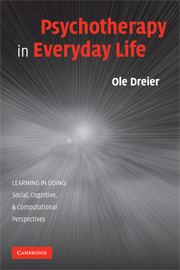Book contents
- Frontmatter
- Contents
- Series Foreword
- Preface
- Introduction
- 1 Re-Searching Psychotherapy as a Social Practice
- 2 Theorizing Persons in Structures of Social Practice
- 3 A Study – Its Design and Conduct
- 4 Clients' Ordinary Lives Plus Sessions
- 5 Therapy in Clients' Social Practice across Places
- 6 Changes in Clients' Practice across Places
- 7 Changing Problems across Places
- 8 The Conduct of Everyday Life and the Life Trajectory
- 9 The Children's Changing Conducts of Everyday Life and Life Trajectories
- 10 The Parents' Changing Conducts of Everyday Life and Life Trajectories
- 11 The Changing Conduct of Everyday Family Life and Family Trajectory
- 12 Research in Social Practice
- References
- Author Index
- Subject Index
- Learning in Doing: Social, Cognitive, and Computational Perspectives
4 - Clients' Ordinary Lives Plus Sessions
Published online by Cambridge University Press: 15 December 2009
- Frontmatter
- Contents
- Series Foreword
- Preface
- Introduction
- 1 Re-Searching Psychotherapy as a Social Practice
- 2 Theorizing Persons in Structures of Social Practice
- 3 A Study – Its Design and Conduct
- 4 Clients' Ordinary Lives Plus Sessions
- 5 Therapy in Clients' Social Practice across Places
- 6 Changes in Clients' Practice across Places
- 7 Changing Problems across Places
- 8 The Conduct of Everyday Life and the Life Trajectory
- 9 The Children's Changing Conducts of Everyday Life and Life Trajectories
- 10 The Parents' Changing Conducts of Everyday Life and Life Trajectories
- 11 The Changing Conduct of Everyday Family Life and Family Trajectory
- 12 Research in Social Practice
- References
- Author Index
- Subject Index
- Learning in Doing: Social, Cognitive, and Computational Perspectives
Summary
The practice of therapy complements other arrangements people use to get through the day and as parts of their life trajectories (Foucault 1997; Hook 2003; Strauss and Corbin 1988). Attending therapy means entering its structural arrangement which has been infused with the ordinary understanding of therapy that emerged from practicing in it so completely that it is taken for granted and its impacts ignored. Like many other social practices, therapy is carried out in one place with a particular set of participants, even though it primarily deals with issues from other times and places. Its tasks originate elsewhere, and its effects are to make a difference elsewhere. It is arranged as a sequence of secluded sessions that are to allow particular experiences and activities. This then ought to be the most suitable arrangement for promoting its purpose across contexts. When clients begin therapy, they get involved in this arrangement which frames their experiences and participation in sessions. They enter an extra, personally unknown practice with personally unknown experts and for a period of time add participation in it to their ordinary lives. I shall begin my analysis of the practice of therapy from the clients' perspective in the same way. Drawing on materials from the early parts of therapy and following up with later events I shall look at how their participation in sessions begins to unfold and how they begin to link it with their ordinary lives.
- Type
- Chapter
- Information
- Psychotherapy in Everyday Life , pp. 58 - 83Publisher: Cambridge University PressPrint publication year: 2007



